Kine Exakta
The story of the Kine Exakta begins in 1932 when the design engineer
Karl Nuchterlein at the Ihagee Kamerawerk, Steenbergeen & Co. Dresden
was in the process of developing the standard Exakta of 4 x 6,5 cm
format. That year was remarkable for the introduction of the Zeiss
Contax, and of Agfa's new 35mm cartridge: It was also the year in
which, one might say the Leica came of age on the introduction of the
model II with a coupled rangefinder. It is not surprising, therefore,
that Nuchterlein should have begun to plan a 35mm single lens reflex
in that year, and when the standard Exakta was into production in
1933, to have commenced the development of the Kine Exakta.
Preliminary designs were in fact on paper in June 1932.
The first 35mm SLR
Collectors have frequently debated whether or not this distinction
should go to the Russian "Cnopm" or Sport. The last year or two has
given opportunity for close enquiries to be made in Dresden and in
Leningrad and Moscow. In particular information provided by the
Polytechnical Museum, Moscow states that a prototype 35mm SLR was made
in 1934 and this was improved and developed into the camera that
became the Sport. "In 1937 it was perfected and brought into a state
for production. The standard production began at the end of 1937,
beginning of 1938".
|
|
Something Unique
What then was so special about this camera? The photographic world at
that time was used to large reflex plate cameras in which the image
could be scrutinised at the full size of the negative, and even the
standard Exakta, though very much smaller than other reflexes, had
this characteristic. Many were sceptical about the practical
possibility of a reflex for such a small negative as 24 x 36 mm. To
meet this the Kine Exakta focussing screen was of condenser form which
not only added brilliance but also provided an image magnified two
diameters, which was further increased by the magnifier: The screen
was the subject of a patent dated 13 november 1934. The original round
magnifier was quickly recognized as giving too limited a view and was
replaced by the rectangular magnifier in December 1936.
A remarkable shutter
From the first the camera had the amazing 20 speed shutter, from 12
seconds to 1/1000, with delayed action on 14 of the speeds. It had
lever wind which was simple logic put on the user's left, believing
that the importance of the focussing function demanded the use of the
right hand. This winding advanced the film, wound the shuttere, set
the mirror, moved the exposure counter, and prevented unintentional
double exposures. The hood provided, in addition to the magnifier, a
direct vision viewfinder for eye-level use, and when closed locked the
shutter release.
|
|
Other new features
The camera also introduced the concept of a shutter release button
placed on the front of the body, operating parallel to the optical
axis. There was a built in knife to cut the film, for quick
development of short lengths: It was the first 35mm camera to have
built in synchronization, and an accessory flash gun to take the
Vacublitz bulb was marketed. Nuchterlein actually patented a system of
TTL metering on 28 July 1939 but owing to his untimely death in the
war it did not come into production. In 1958 Ihagee introduced a
pentaprism with a built-in selenium meter and also an accessory TTL
meter (which slightly extended the lens) for laboratory use.
Precision
Fundamental to the whole design was the determination to build a
camera characterised by precision and versatility, which is why it
became so extensively used for medical and scientific purposes, and it
must be a tribute to the designer that it continued with only minor
change until 1949. In this period it was undoubtedly the most
influential design in camera manufacture. It then gave birth to
improvements that made it even more versatile.
The body was of die-cast light alloy weighing only about 30 ozs with
the lens. It had a
bayonet mount, and
initially there was a choice of 5 standard lenses of 50 or 58mm focal
lenght, and 5 long focus lenses. |
|
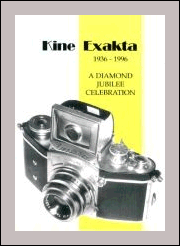
The Kine Exakta was exhibited at the Leipzig Spring Fair in March 1936
and was in production from April 1936.
The Kine Exakta was selling in London in 1937 with f2,8 Tessar for
£38.10.0, and with f2.0 Biotar for £55.00.
The Kine Exakta II came in 1949. The Varex, with the great
advantage of interchangeable viewfinders in 1950; the Varex VX in
1951; Varex IIa in 1957; Varex IIb 1963; VX 1000 with instant return
mirror in 1967; VX 500 in 1969; and the RTL 1000 in 1970. In the USA
the Varex was labelled V and the Varex VX as VX because Argus Inc. had
copyright of the name Varex
|
|
The
pre-production Kine Exakta earned its name because of it's many
different parts and earliest known serial number of 455681. All other
know round magnifier Kine Exaktas have numbers starting with 48xxxx
It's probably more accurate to describe this camera as being from an
early small production run assembled with many pre-production parts
rather than an actual pre-production prototype. The only other Kines
seen with the low 4556xx numbers are shown in the first Kine brochures
and in the first Kine instruction book. There is one other Kine that
has survived from this batch but unfortunately it had been used for
parts when it was found and was missing its serial number plate, fast
speed selector and round magnifier plate. This leads one to believe
there could be a later Kine out there somewhere that has been
"restored" using the parts from this other early Kine. If this is so,
a later round magnifier Kine may surface at some time with a 4556xx
number but without all the differences of these very early cameras.
|
|
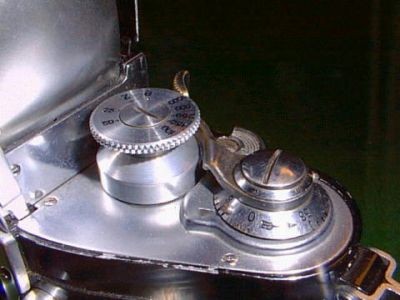
The frame counter starts with 0, not 1 like the later cameras. There
is no arrow on the top of the speed selector and the height of the
base of the speed selector is taller.
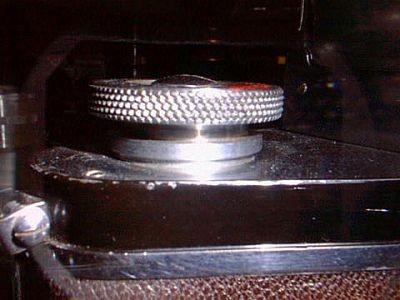
The slow speed selector is like the Vest Pocket Exaktas, without a
groove milled in the center. At first I thought it had been replaced
with a VP knob but when I removed it and checked it against several
knobs in my VP collection I found they were different.
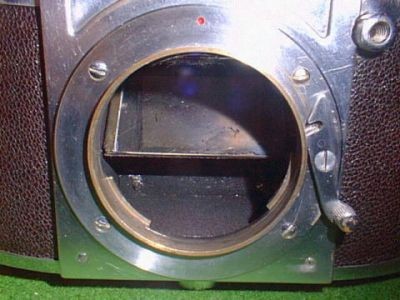
You can easily see the mirror is shorter and straight cut across at
the bottom, without the classic early Exakta tapered front.
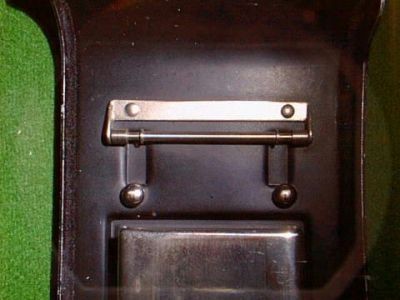
The film roller guide is in a slightly different position and the arms
holding the roller are longer.
|
|
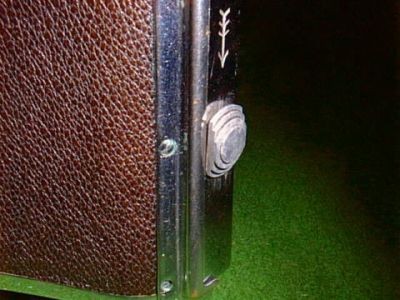
There is one less step in the machined steps of the back door release
button
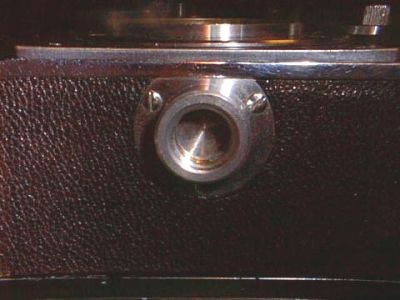
Two of the tripod mount screws are further forward on the early
camera. This is interesting because these two screws actually
interfere with the internal mechanism and do not have nuts holding
them on the inside like later cameras. There is only one internal nut
on the single back screw. I can't believe Ihagee would have shipped
cameras like this because there is virtually no strength with 2 of the
3 mount screws screwed into only 1.5 mm of aluminum. This camera
mounted on a tripod bearing a heavy lens would have torn the tripod
mount from the camera!
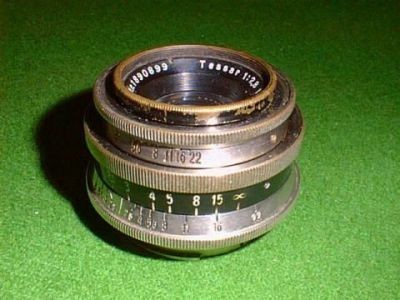
Although this lens did not come with this camera (the whereabouts of
it's original lens is unknown) it is the earliest known lens in
existence for a Kine Exakta and it seems fit that it resides on this
camera! It is a nickel and black paint 50 2.8 Tessar #1890899. |
|
|
Other differences not
shown in the photos are:
Several chromed parts are bright and not brushed matte.
Film cutting knife knob has finer knurling.
Rewind fork is made from thinner material and is attached
differently to the rewind knob.
Film sprocket guide is attached to the film guide plate directly,
not the body casting like later cameras. If you have a Kine
instruction book you'll see that the guide is not there at all, so it
appears it was added later to this camera. The guide itself is a
little different in it's shape than later cameras as well.
Upon internal inspection there appears to be a lot of grinding to
the body casting in order for the internal shutter/mirror box unit to
fit
|

The Kine Exakta Hologram
In celebration of the
60th anniversary of the Kine Exakta
These bright 3d holografic images are made
with an argon ion laser on hand-coated swiss glass
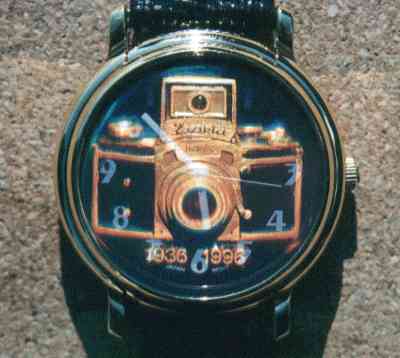
a great collector's item |
|